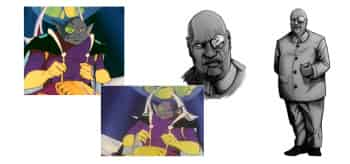Bonus
-
Making a plan and being able to deviate from it – Part 2
The story “The Transaction” wasn’t in our initial plan. It was added to plug a temporal gap between two significant events in the storyline. The character of Balthazar was developed for that purpose. In fact, many of the stories from 1993 and 1994 were created to fill that gap. Editor Jordan D. White gives a good overview of the situation: “But it’s always important to keep those long-term plans as loose as possible—there is a really good chance that by the time we finish writing the first arc, we’re going to have a different idea of where we’re going than we started with—or at least a different idea of how to get there” (“Jordan D. White Reveals the Secrets of Editing,” Steve Morris, comicsbeat.com, October 21, 2012).
-
The origins of Desmond
We imagined Desmond as a stout man of African origin. We wanted his appearance to be a little more caricatured, hence, the bald head, which is frequently associated with villains. To emphasize this aspect, we drew inspiration from Commander Hydro, as he appears in episode 48 of the series Goldorak, where one of his eyes is replaced by a diamond.

-
Making a plan and being able to deviate from it – Part I
At the end of his time at Marvel, where he mainly worked on the Captain America series, Ed Brubaker said the following: “I hoped for two years, and planned for three, because three years was about the longest I’d stayed on any other book. My pitch document had the first 12 issues mapped out, which I mostly stuck to, actually, and then sketched out the next year in broad strokes. I never imagined I’d go even 50 issues, let alone the I think 102 issues I did, counting mini-series and one-shots and annuals.” He also added, “More than anything, it was that each issue kept wanting to be longer or I kept feeling like I had more ideas and wanted to spend more time with the characters, and realized I was stopping myself from doing that with an arbitrary structure I’d imposed on myself” (“The Ed Brubaker ‘Captain America’ Exit Interview,” David Brothers, comicsalliance.com, November 1, 2012).
There are two opposing ideas here: the idea of a plan that guides the author, and the idea of the flexibility the writer must maintain to include new ideas or developments that hadn’t been originally anticipated. In our project, one of the ideas that just evolved like that was Votan’s identity. At first, he was going to remain mysteriously anonymous over a number of stories, if not all the way to the end, but ultimately, we dropped that concept, preferring instead to reveal his identity quickly, because this opened up more dramatic opportunities.
-
References in “The Third Mission”
We saw a documentary on the Cold War, in which people suspected that certain suicides were actually a cover-up for murders. One of the ways these murders were supposed to have been done was by knocking the victim out on the edge of a window and then throwing them out of it. We also recalled the suicide in the summer of 2010 of a patient in a Montreal hospital, who jumped from a ninth-floor window. We put these two unrelated anecdotes together to write our story.
-
Peppering the story with events to create movement
A few months ago, we watched the fourth installment in the Mission Impossible series, and we couldn’t help but ask, “Why?” with each passing scene: why are all the operations, which are supposed to make the team’s mission move forward, ending up in failure? Especially when another course of action that was possible at the beginning of the scene would have allowed them to achieve the same goal? For example, after their mission to get into the Kremlin to discover a criminal’s identity doesn’t succeed, the big boss then comes along and tells them who the bad guy is. So why take such a roundabout path when a shortcut is available? Certainly, we understand the challenges faced by a writer who has to create an adventure that fits into a given time format. But such a convoluted storyline doesn’t seem a great way to create suspense. As it says in Pixar’s “22 Rules of Storytelling,” “Coincidences to get characters into trouble are great; coincidences to get them out of it are cheating.” (“Pixar and Joss Whedon’s Rules for Writers,” Russ Burlingame, comicbook.com, December 8, 2012).






